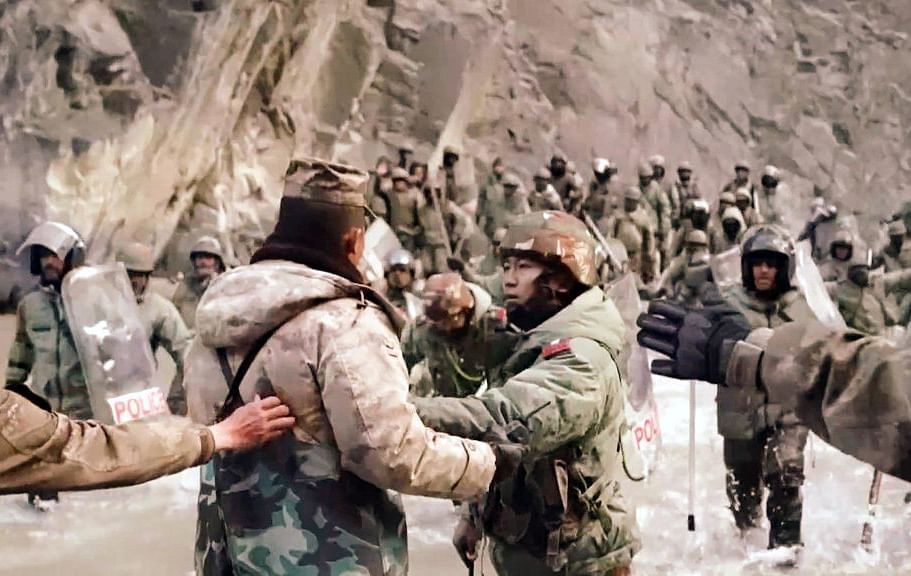Even those who were not lucky enough to visit Pangong Tso in eastern Ladakh had a glimpse of its mesmerising beauty in one of the most popular Amir Khan starrer 3 Idiots.
At times, the beauty poses serious strategic challenges, and that’s what has happened now. This lake, until two years ago, was placid and a symbol of uncomfortable reconciliation between India and China.
Now it is bringing out the hard truth: China is constructing a bridge across the lake. It reestablishes that China is not interested in settling the border dispute with India, and second, more menacingly, it is moving aggressively, threatening the areas and the waters which are with India legally for ages. It concerns Jammu and Kashmir more, particularly
Jammu region. General Zorawar Singh had brought this area under the control of Dogra kingdom in 19thcentury. That is now history.
The construction of the bridge is going on at the time when there has been more than 20-month long standoff between PLA troops and the Indian army.
What does this bridge across the lake mean for China and India? Let there be a dispassionate look at what is there on the ground. The 135-km-long lake of shimmering waters is in the Union Territory of Ladakh that parted ways on the map of the erstwhile state of J&K on October 31, 2019, though the bifurcation was announced on August 5 , 2019.
“Government ( of India) been monitoring this activity closely. This bridge is being constructed in areas that have been under illegal occupation by China for around 60 years. Govt taking steps to ensure our security interests are protected,” MEA spokesperson Arindam Bagchi said at a media conference on January 7, days after the newspapers were filled with headlines of Chinese construction across the lake.
There were three major points worth understanding: (a) the Chinese were constructing bridge in the areas under the illegal occupation of China for around 60 years – the reference was too obvious that this particular area was lost to China in the 1962 war. Its implication is that very little can be done to resist the Chinese action except issuing a statement.
The real thing is that China is making presence of its hard power felt in the area without any fear of being challenged physically. It is advancing its hard-power strategy through concrete and steel, along with the troops. Beijing resorts to this kind of expansionism almost everywhere, wherever it can.
This is a bridge, the pictures of which would be shown in two frames: China is building the bridge to show to the posterity that it was doing everything in the areas and the watery bodies, which belonged to it, and once that status is acquired or furthered, it will become permanent and any number of new lines on the map would not be able to change the alternative reality of this day.
The point (B) in the MEA statement is, steps were being taken to ensure our security interests are protected. It translates into acknowledgement of the threats that have appeared on the horizon for the security of the country’s interests. And realistically speaking it is a defensive mode . A blunt question is, what is the counter strategy.
China had started construction in its areas close to the LAC, including those which China had captured 60 years ago. There was construction of roads, airfields and other infrastructure that could help their population and speedy movement of PLA troops. No one woke up to this challenge until 2008. The fault lies with the governments that ignored the strategic threats emerging in the region.
Squeamishness was seen as the best way out. It was an escapist way of doing things. Perhaps the governments lived in 1962 syndrome. They were shy of annoying China, an Asian giant overpowering everything. From a military power, it has grown into an economic tiger, now baring teeth at the United States of America. The strategic minds across the world have announced the start of second Cold War.
India is a close ally of the United States, but at the same time it cannot be in one grouping because it has its own geographical, political and diplomatic interests to guard and compulsions to contend with. In the past five-six years, when the government focused on strategic means to guard the strategic assets – Atal Tunnel, major roads toward the critical points dotting the LAC in eastern Ladakh – China discovered something is changing in India. So, it has started moving ahead in building its infrastructure.
The difference is that India is constructing what all is needed for its security, and China is doing it in the illegally occupied areas in pursuance of its expansionist policy.
The point (C) is that the emerging scenario is a by-product of the 20-month-long standoff, a euphemism to say that the two sides can do everything possible to defeat the designs of the adversary. The reality is less palatable. Chinese asserts that “China’s infrastructure construction on its territory is entirely within its sovereignty and is aimed at safeguarding China’s territorial sovereignty and security as well as peace and stability in the China -India border area .”
This statement tells more than what is happening at the lake; new borderlines are being pushed through. First, China claims it is its own territory, and then it links it to peace with India in border area, making it clear that any opposition would be an act of breach of peace. Pangong waters are not placid anymore.
Disclaimer: The views and opinions expressed in this article are the personal opinions of the author.
The facts, analysis, assumptions and perspective appearing in the article do not reflect the views of GK.







